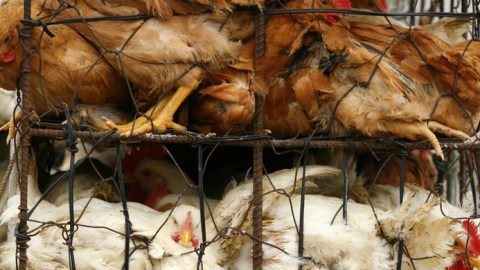We’re Ethically Bound to Eat Braindead, Legless Chickens

A recent proposal to remove the heads and legs of chickens may be the best thing we can do for them.
If we can reduce our farmed animals to vegetables, we would have made great strides in reducing suffering. That is, if we can remove the functions of the brain that cause animals to suffer during farming, we should do so.
Perhaps, ultimately, it would be best if we could produce scientifically-engineered meat without the trouble of a sentient entity growing it through its natural life-cycle. Until then, it seems we should at least remove sentience as far as we are able, to rid them of needless suffering.
This was indeed the goal of architectural student André Ford, in a recent display of a project proposing new farming methods – that improves efficiency and the conditions of chickens in factory farming. The “Headless Chicken Solution” proposes (quoting Olivia Solon from Wired): “removing the cerebral cortex of the chicken to inhibit its sensory perceptions so that it could be produced in more densely packed conditions without the associated distress. The brain stem for the chicken would be kept intact so that the homeostatic functions continue to operate, allowing it to grow.” The homeostatic functions are of course necessary for the rest of the chicken’s body to function.
The problem with the broiled meat industry is demand: too much meat demanded in too little time. This means the chickens themselves have been subjected to various procedures so they grow faster, causing them great suffering, since they are also packed densely – unable to move, resulting in boredom, cannibalism and so on – and some organs fail, like their heart and lungs, because these are unable to match the chicken’s body’s rapid growth.
Ford proposes that using vertical space (I’ll explain shortly) and making the chickens headless would solve significant parts of this.
He says:
“As long as their brain stem is intact, the homeostatic functions of the chicken will continue to operate. By removing the cerebral cortex of the chicken, its sensory perceptions are removed. It can be produced in a denser condition while remaining alive, and oblivious.
The feet will also be removed so the body of the chicken can be packed together in a dense volume.
Food, water and air are delivered via an arterial network and excreta is removed in the same manner. Around 1000 chickens will be packed into each ‘leaf’, which forms part of a moving, productive system.”
Without legs (since they don’t need to walk) or heads the chickens physically take up less space; without their cortex they also don’t suffer. In such a state, the chickens can be packed into racks literally on top of one another (see picture), so there is more economic use of space. Wastes would be removed just as nutrients are supplied.
Why Such Ideas Matter
What’s fascinating for me is that aside from Mr Ford’s compassion being channeled through clarity of thought and analysis, is how eliciting repugnance here is itself a reminder of what occurs everyday – in much worse conditions. Indeed, it’s hard to identify what’s wrong with Mr Ford’s idea (which is only a project, but can and should be taken further).
The major point of contention might be the decision of when and how to remove the cortex. Yet, this seems a bizarre worry compared to what would otherwise happen to the chickens. If we are unable to grow chickens without feelings, legs, and so on – indeed, if we are unable to make cheap so-called Frankenmeat – the best we can do is to reduce the suffering in the currently existing model. Many people’s repugnance brings to light the complicit nature they have in continuing to cause suffering to these creatures.
We do much by either not eating meat, choosing places that farm ethically, or at least being aware of the conditions of these future meat machines. However, it seems to me that if such a system can be implemented we should do all we can to make it so. This doesn’t undermine the current industry, since (1) the demand would be more effectively handled, due to an increase in space and production and (2) there would probably be no fierce charges of animal abuse, since the animals can’t be abused after the cortex is removed.
This all presumes we accept that suffering is an important benchmark for ethics (for me it is essential) and, no doubt, many of us do not. The ethics of eating is a highly provocative subject, since it’s an area – like the ethics of child breeding – which many people don’t really consider, until it’s challenged.
But it seems, again, we can’t let our outrage of headless, legless chickens prevent us from taking steps to reduce their suffering. The deception is that because they are in such a headless, legless state they are, somehow, worse, whereas the evidence plainly tells us their current conditions are truly horrific. It is better for them, and indeed us, that they be put in such a state so that they do not suffer while being farmed.
Perhaps some will say they are “losing out” on some kind of meaningful existence. That depends on how we define meaningful: If we mean “running free” in farms, that would be fine – yet battery chickens would not be in such positions to even be free. Secondly, we know that they suffer since we can see their broken bones and failing organs when in the current conditions. I’m not sure what’s meaningful about the current state of this kind farming (again, this assumes unethical farming as it occurs in factories).
It seems then that, implementing Ford’s type of policy, chickens are not losing out on a meaningful life, but indeed are benefiting from being removed from the suffering they would otherwise endure.




